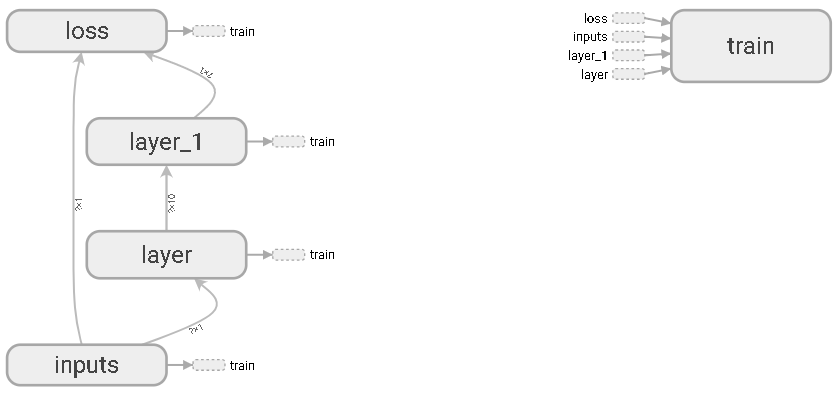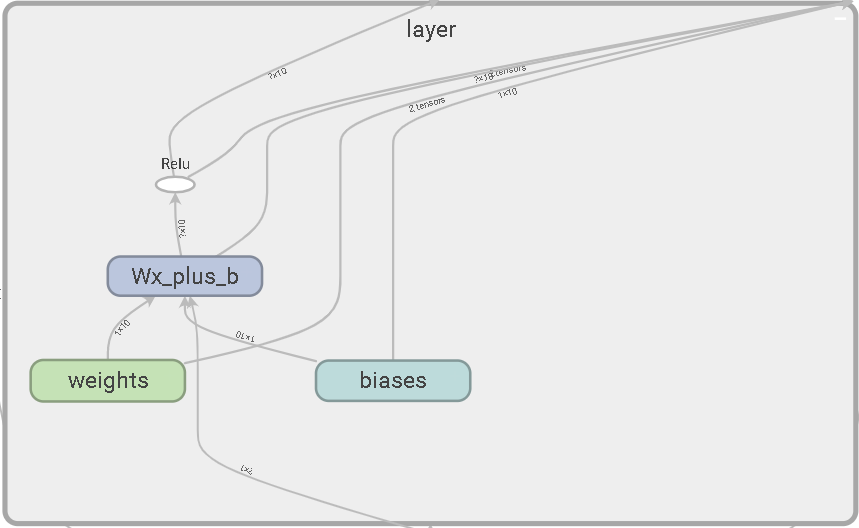1. session对话控制
matrix1 = tf.constant([[3,3]]) matrix2 = tf.constant([[2],[2]]) product = tf.matmul(matrix1,matrix2) #类似于numpy的np.dot(m1,m2)
方法1:
sess = tf.Session() result = sess.run(product) print(result) # [[12]] sess.close()
方法2:
with tf.Session() as sess:#不需要手动关闭sess
result2 = sess.run(product)
print(result2) # [[12]]
2. Variable变量
state = tf.Variable(0,name='counter')
#定义常量 one
one = tf.constant(1)
#定义加法步骤(注:此步并没有直接计算)
new_value = tf.add(state,one)
#将 State 更新成 new_value
update = tf.assign(state,new_value)
# 如果定义 Variable, 就一定要 initialize
# init = tf.initialize_all_variables() # tf 马上就要废弃这种写法
init = tf.global_variables_initializer() # 替换成这样就好
with tf.Session() as sess:
sess.run(init)
for _ in range(3):
sess.run(update)
print(sess.run(state))
>>>1
2
3
3. placeholder
Tensorflow 如果想要从外部传入data, 那就需要用到 tf.placeholder(), 然后以这种形式传输数据 sess.run(***, feed_dict={input: **}).
接下来, 传值的工作交给了 sess.run() , 需要传入的值放在了feed_dict={} 并一一对应每一个 input. placeholder 与 feed_dict={} 是绑定在一起出现的。
input1 = tf.placeholder(tf.float32) #大部分只能处理float32
input2 = tf.placeholder(tf.float32) #两行两列[2,2]
output = tf.multiply(input1,input2)
with tf.Session() as sess:
print(sess.run(output,feed_dict={input1:[2.],input2:[1.]}))
>>>[2.]
4. 添加层def add_layer()
import tensorflow as tf
def add_layer(inputs,in_size,out_size,activation_function=None):
with tf.name_scope('layer'):
with tf.name_scope('weights'):
Weights = tf.Variable(tf.random_normal([in_size,out_size]),name='W')
biases = tf.Variable(tf.zeros([1,out_size])+0.1)
Wx_plus_biase = tf.add(tf.matmul(inputs,Weights),biases)
if activation_function == None:
outputs = Wx_plus_biase
else:
outputs = activation_function(Wx_plus_biase)
return outputs
5. 搭建神经网络
import numpy as np
x_data = np.linspace(-1,1,300)[:,np.newaxis]
noise = np.random.normal(0,0.05,x_data.shape).astype(np.float32)
y_data = np.square(x_data) - 0.5 + noise
# 利用占位符定义我们所需的神经网络的输入。 tf.placeholder()就是代表占位符,这里的None代表无论输入有多少都可以,因为输入只有一个特征,所以这里是1。
with tf.name_scope('inputs'):
xs = tf.placeholder(tf.float32,[None,1],name='x_input')
ys = tf.placeholder(tf.float32,[None,1],name='y_input')
#层
l1 = add_layer(xs,1,10,activation_function=tf.nn.relu)
prediction = add_layer(l1,10,1,activation_function=None)
#loss
loss = tf.reduce_mean(tf.reduce_sum(tf.square(ys-prediction),
reduction_indices=1))
#优化器
train_step = tf.train.GradientDescentOptimizer(learning_rate=0.1).minimize(loss)
# init = tf.initialize_all_variables() # tf 马上就要废弃这种写法
init = tf.global_variables_initializer() # 替换成这样就好
sess = tf.Session()
sess.run(init)
for i in range(1000):
sess.run(train_step,feed_dict={xs:x_data,ys:y_data})
if i % 50 == 0:
# to see the step improvement
print(sess.run(loss, feed_dict={xs: x_data, ys: y_data}))
结果如下:

6. 结果可视化
import matplotlib.pyplot as plt
fig = plt.figure()
ax = fig.add_subplot(1,1,1)
ax.scatter(x_data,y_data)
# plt.ion() #plt.ion()用于连续显示
# plt.show()
# 每隔50次训练刷新一次图形,用红色、宽度为5的线来显示我们的预测数据和输入之间的关系,并暂停0.1s。
for i in range(1000):
sess.run(train_step,feed_dict={xs:x_data,ys:y_data})
if i % 50 == 0:
try:
ax.lines.remove(lines[0])
except Exception:
pass
prediction_value = sess.run(prediction,feed_dict={xs:x_data})
lines = ax.plot(x_data,prediction_value,'r-',lw=5)#线宽度=5
# ax.lines.remove(lines[0])#去除lines的第一个线段
plt.pause(0.1) #暂停0.1s
# plt.show()

7. TensorFlow的优化器
tf.train.GradientDescentOptimizer tf.train.AdadeltaOptimizer tf.train.AdagradDAOptimizer tf.train.MomentumOptimizer tf.train.AdamOptimizer tf.train.FtrlOptimizer tf.train.RMSPropOptimizer
8. 可视化神经网络
# 图纸搭建 指定这里名称的会将来在可视化的图层inputs中显示出来
import tensorflow as tf
with tf.name_scope('inputs'):
# define placeholder for inputs to network
xs = tf.placeholder(tf.float32,[None,1],name='x_in')
ys = tf.placeholder(tf.float32,[None,1],name='y_in')
def add_layer(inputs, in_size, out_size, activation_function=None):
# add one more layer and return the output of this layer
with tf.name_scope('layer'):
with tf.name_scope('weights'):
Weights = tf.Variable(
tf.random_normal([in_size, out_size],name='W'),
name='W')
with tf.name_scope('biases'):
biases = tf.Variable(tf.zeros([1, out_size]) + 0.1,name='b')
with tf.name_scope('Wx_plus_b'):
Wx_plus_b = tf.add(
tf.matmul(inputs, Weights),
biases)
if activation_function is None:
outputs = Wx_plus_b
else:
outputs = activation_function(Wx_plus_b, )
return outputs
#层
l1 = add_layer(xs,1,10,activation_function=tf.nn.relu)
prediction = add_layer(l1,10,1,activation_function=None)
# the error between prediciton and real data
with tf.name_scope('loss'):
loss = tf.reduce_mean(
tf.reduce_sum(
tf.square(ys - prediction),
# eduction_indices=[1]
))
with tf.name_scope('train'):
train_step = tf.train.GradientDescentOptimizer(0.1).minimize(loss)
sess = tf.Session() # get session
# tf.train.SummaryWriter soon be deprecated, use following
writer = tf.summary.FileWriter("E:/logs", sess.graph)
sess.run(tf.global_variables_initializer())

inputs输入层

隐藏层layer

隐藏层layer1

损失函数

训练

9. 可视化训练过程
输入数据:
import tensorflow as tf
import numpy as np
# 图纸搭建 指定这里名称的会将来在可视化的图层inputs中显示出来
with tf.name_scope('inputs'):
# define placeholder for inputs to network
xs = tf.placeholder(tf.float32,[None,1],name='x_in')
ys = tf.placeholder(tf.float32,[None,1],name='y_in')
## make up some data
x_data= np.linspace(-1, 1, 300, dtype=np.float32)[:,np.newaxis]
noise= np.random.normal(0, 0.05, x_data.shape).astype(np.float32)
y_data= np.square(x_data) -0.5+ noise
添加层:
def add_layer(inputs ,
in_size,
out_size,n_layer,
activation_function=None):
## add one more layer and return the output of this layer
layer_name='layer%s'%n_layer
with tf.name_scope(layer_name):
with tf.name_scope('weights'):
Weights= tf.Variable(tf.random_normal([in_size, out_size]),name='W')
# tf.histogram_summary(layer_name+'/weights',Weights)
tf.summary.histogram(layer_name + '/weights', Weights) # tensorflow >= 0.12
with tf.name_scope('biases'):
biases = tf.Variable(tf.zeros([1,out_size])+0.1, name='b')
# tf.histogram_summary(layer_name+'/biase',biases)
tf.summary.histogram(layer_name + '/biases', biases) # Tensorflow >= 0.12
with tf.name_scope('Wx_plus_b'):
Wx_plus_b = tf.add(tf.matmul(inputs,Weights), biases)
if activation_function is None: #最后一层不需要激活
outputs=Wx_plus_b
else:
outputs= activation_function(Wx_plus_b)
# tf.histogram_summary(layer_name+'/outputs',outputs)
tf.summary.histogram(layer_name + '/outputs', outputs) # Tensorflow >= 0.12
return outputs
损失函数:
with tf.name_scope('loss'):
loss= tf.reduce_mean(tf.reduce_sum(
tf.square(ys- prediction), reduction_indices=[1]))
# tf.scalar_summary('loss',loss) # tensorflow < 0.12
tf.summary.scalar('loss', loss) # tensorflow >= 0.12
接下来,开始合并打包。 tf.merge_all_summaries()方法会对我们所有的summaries合并到一起。因此在原有代码片段中添加:
sess= tf.Session()
# merged= tf.merge_all_summaries() # tensorflow < 0.12
merged = tf.summary.merge_all() # tensorflow >= 0.12
# writer = tf.train.SummaryWriter('logs/', sess.graph) # tensorflow < 0.12
writer = tf.summary.FileWriter("logs/", sess.graph) # tensorflow >=0.12
# sess.run(tf.initialize_all_variables()) # tf.initialize_all_variables() # tf 马上就要废弃这种写法
sess.run(tf.global_variables_initializer()) # 替换成这样就好
训练
for i in range(1000):
sess.run(train_step,feed_dict={xs:x_data,ys:y_data})
if i % 50 == 0:
result = sess.run(merged,feed_dict={xs:x_data,ys:y_data})
writer.add_summary(result,i)
(1)DISTRIBUTIONS

(2)EVENTS
# tf.scalar_summary('loss',loss) # tensorflow < 0.12
tf.summary.scalar('loss', loss) # tensorflow >= 0.12

(3)HISTOGRAMS
# tf.histogram_summary(layer_name+'/biase',biases) # Tensorflow < 0.12 tf.summary.histogram(layer_name + '/biases', biases) # Tensorflow >= 0.12

参考文献:
【1】莫烦Python